Solar arrays, like all electronic devices, are prone to surges in voltage that can harm components and increase downtime. Surge protection devices can help keep systems running and profitable.
Think of a home or office computer. In addition to the desktop or laptop, there may be an external monitor, speakers and even a printer. That’s too many components to plug into a wall outlet, so most people purchase a power strip. But that power strip is more than just a convenient method of plugging a bunch of stuff into one outlet; it actually helps protect those electronics from the harmful effects of power surges.
A power surge, also called a transient voltage, is a generally short increase in voltage that’s well above normal levels. For example, the standard voltage for a home or office is 120 V. Voltage can be thought of as electrical pressure. So just as too much water pressure will burst a garden hose, too high a voltage could damage electronics. These surges can come from natural sources, such as lightning, as well as internal or external equipment on the grid.
A surge protector helps prevent damage to electronics by diverting the extra electricity from the “hot” power line into a grounding wire. In most common surge protectors, this is achieved through a metal oxide varistor (MOV), a piece of metal oxide joined to the power and grounding lines by two semiconductors.
Solar needs surge protection
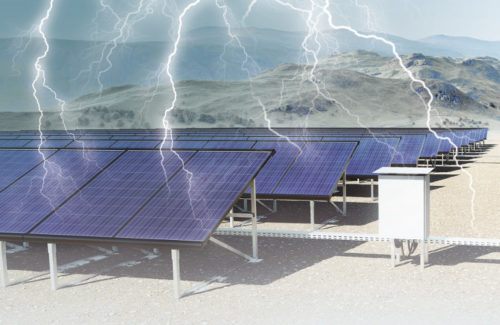 Solar arrays are also electronic devices and so are subject to the same potential for damage from surges. Solar panels are especially prone to lightning strikes due to their large surface area and placement in exposed locations, such as on rooftops or ground-mounted in open spaces.
Solar arrays are also electronic devices and so are subject to the same potential for damage from surges. Solar panels are especially prone to lightning strikes due to their large surface area and placement in exposed locations, such as on rooftops or ground-mounted in open spaces.
“Coincidentally, California, where the solar industry has enjoyed its most rapid scale-up, has one of the lowest risks for lightning in the United States,” said Dan Sylawa, senior business development manager of renewable energy at Phoenix Contact, which provides surge protection devices (SPDs). “As solar power installations have moved beyond the California market, the potential impact of lightning-induced array failures has increased. This has been most evident as array installations have moved into the Southeastern United States, one of the most lightning-prone areas of the country.”
Solar contractors aren’t always aware if they’re building in a lightning-prone area. Alltec, which also provides SPDs, incorporates data from the U.S. Lightning Detection Network in a free tool that allows solar contractors to assess the lightning risk of their projects.
Lightning is about 50,000°F—five times hotter than the sun—so it’s not surprising it can be detrimental to solar equipment.
“If the solar panels are struck directly, lightning can burn holes in the equipment or even cause explosions, and the entire system is destroyed,” said Ethan Pace, SPD product manager at Alltec.
But the effects of lighting and other overvoltages aren’t always so strikingly apparent. Sylawa said that the secondary effects of these events can not only affect major components such as modules and inverters, but also monitoring systems, tracker controls and weather stations.
“Secondary effects are often the least recognized risks and frequently perceived as infant mortality failures or manufacturing defects,” he said. “Loss of a PV module will only mean loss of a string, while loss of central inverter will mean loss of the power generation for a large section of the plant.”
Installing surge protection devices
Because all electrical equipment is susceptible to surges, SPDs are available for all solar array components. The industrial versions of these devices also use metal oxide varistors (MOV) in combination with other sophisticated equipment to conduct surge overvoltages to grounding. Therefore, SPDs are generally installed after a stable grounding system is in place.
“Think of an electrical single-line diagram of your installation and cascade SPDs from the utility service to the array equipment,” Pace said. “Locate robust protection on main entrances to protect against large surge transients and smaller units down critical paths to the equipment end-point.”
A SPD network should be installed throughout the solar array’s AC and DC power distribution to protect critical circuits. SPDs should be installed on both the DC inputs and AC outputs of the system’s inverter(s) and be deployed with reference to ground on both the positive and negative DC lines. AC protection should be deployed on each power conductor to the ground. Combiner circuits should also be protected, as should all control circuits and even tracking and monitoring systems to prevent interference and data loss.
When it comes to commercial and utility-scale systems, Sylawa suggests using the 10-m rule. For installations with DC cable lengths under 10 m (33 ft), DC solar surge protection should be installed at a convenient point such as at inverters, combiner boxes or closer to the solar modules. For installations with DC cabling over 10 m, surge protection should be installed at both the inverter and module ends of the cables.
Residential solar systems with microinverters have very short DC cabling, but longer AC cables. An SPD installed at the combiner box can protect the home from array surges. An SPD on the main panel can protect the home from array surges as well, in addition to those from utility power and other internal equipment.
In any size system, SPDs should be installed by a licensed electrician in accordance with manufacturer recommendations and installation and electrical codes to maximize safety and effectiveness.
Additional steps, such as adding lightning air terminals, can be taken to further protect a solar array specifically from lighting.
“People have to determine what their acceptable risk is,” said Jim Grasty, engineering manager for systems and services at Alltec. “If there’s a continuity of service requirement, then you need lightning protection. If there isn’t, some may elect not to take it.”
Even the most robust surge protection scheme has its limitations. For example, SPDs can’t prevent physical damage from direct lightning strikes.
“This is the best modern science can do,” Grasty said.
Considering costs
While surge protection technology has been around for some time, it has yet to find a permanent presence in the U.S. solar industry. Grasty attributes this to cost.
“We realize solar developers have to be very aware of costs and want to cut initial capital as much as possible, but all they’re doing is transferring the cost to the maintenance budget,” he said. “Who’s going to have to pay for it kind of flows downhill.”
He sees more chance for successful SPD adoption in the residential and small commercial markets because the owner-operator is the one making the purchase. It’s also a lot less expensive to equip a home with surge protection than a large solar array, even though surge protection has a more discernable ROI for utility projects.
“If they’re getting a certain amount of damage per year and then put in the surge suppression and that amount drops to zero, they can see that payback immediately,” he said.
Montana Busch, president and CEO of Georgia-based solar contractor Alternative Energy Southeast, feels the cost pressures of adding surge protection in the competitive residential solar industry.
“We normally recommend it to the extra-cautious customer or those who want to make sure they have all their bases covered,” he said. “However, the tax credit does help cover it. I think it’s smart for installers to research if they’re in a lightning-prone area and at least make the recommendation.”
But Sylawa sees surge protection as critical to ensuring solar’s bankability.
“Solar arrays are expected to operate with a known failure rate during 25 years or more,” he said. “Random failures due to surges and transients lower the financial return. Loss of reliability reduces the value of solar power generation to grid operators. I believe the financial and reliability risks due to surges and transients are under-recognized here in the U.S. market, even though in the global market comprehensive solar array surge protection is commonly employed.”


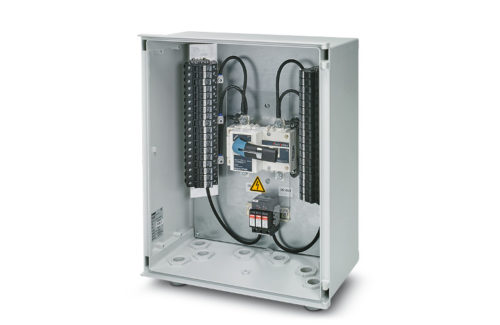
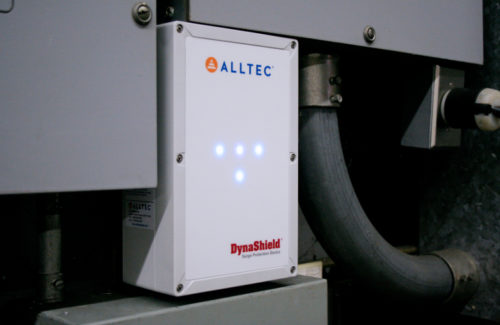
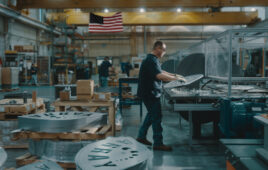


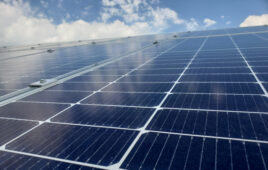
Very useful article for the new comers.
I’m a home owner in India with a 5 kw solar system The Standards here mandate use of both DC and AC side SPDs Additionally, 3 MCCBs have to be provided on the solar meter end the grid supply and the solar AC output
Recently we had a series of lightning strikes
The DC solar SPD blew and the inverter tripped
The AC solar MCCB also tripped The grid line was intact and we didn’t suffer an outage
Switching on the inverter after normalcy was restored resulted in instant tripping of the same two
MCCBs
The inverter was receiving healthy DC voltage from the solar system The inverter being under warranty was opened by the supplier tech The MOVs which were used on the DC side had all shorted and burnt
The board had to be replaced A costly affair
I am wondering if as a practice the MOVs can be mounted separately but adjacent to the inverter board and connected through flat cable to prevent entire board damage Is there a disadvantage?
My next door neighbor recently installed the Tesla solar panel system on her home. I have had at least 2 power surges at my home. One blew out the control panel on my refrigerator; thus, I had to purchase a new refrigerator as the control panel I needed would not be available for several months due to supply chain issues. The next surge I had, about a month later, blew out my air conditioning unit. Is it possible that my neighbor’s solar panel system produces more solar power than they use and that their system feeds their excess power out to the grid; thus, causing a power surge in my home?
I don’t think so.
Can solar flares or solar storms on the sun raise the voltage on your solar panels causing damage to your equipment
A first line of defense , by use of External SPD , is necessitated . A built in feature is useful but in case of any internal damage to SP circuits may lead to warranty problems and or complete replacement of Inverter. where as an external AC/DC is easily replaceable/repairable with out any hassle.
I have residential ongrid 10kw solar system installed in my home. Installer has installed pole breaker before inverter and AC SPD only. Do I need DC SPD as well or it will work fine.
Of course, you need SPD on DC side if your inverter does not come with itself SPD, check inverter operation manual to find out.
Does anyone know the US normative reference to select SPD in photovoltaic systems, particularly in DC combiners and Inverters?
I think there should be power surgers put on them all. The same thing happened to us.
I’m a home owner in Riverside CA. Back in Feb 2019 we had a power surge from the utility co. That burned out our solar Microinverters, the manufacturer will not replace them because they say the warranty does not cover power surge damage. We have power outages often here and I’m afraid to pay to replace the Microinverters without some kind of surge protection. We have only had our solar for five years, what do you recommend?